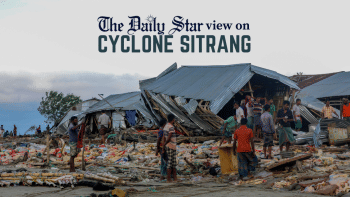Farmers need better protection against crop losses

After every natural calamity, the discussion in Bangladesh tends to veer toward the loss suffered in terms of life. This is perhaps natural, but death toll is an insufficient indicator of the extent of damage suffered by affected communities. After Cyclone Sitrang, which killed at least 35 people since lashing Bangladesh midweek, the focus too has been largely on deaths, or the relative lack thereof, if compared to the last few cyclones. But there are bigger concerns for the battered people who, again, must go through a painful process of relief, rehabilitation and rebuilding to get back on their feet.
The cyclone has left a trail of destruction that may take months, even years, to recover from. Reports indicate that vast stretches of cropland were devastated. In Khulna, for example, crops, vegetables and fruits grown on around 18,483 hectares of land have been reportedly damaged due to heavy rains and strong winds. Meanwhile, fish farms on around 23 hectares of land were also damaged. The same thing happened in Tangail. In Bhola, fishing communities were hit particularly hard. In Barguna, Pirojpur, Shariatpur, Noakhali and other districts, people were similarly affected. Individual accounts from many villages paint a bleak picture as people try to grapple with the post-cyclone reality. Apart from the physical damage to homes and sources of livelihood, there are also concerns about inadequate relief and rehabilitation efforts amidst continued outage in many places, where power lines are yet to be restored.
The immediate priority, of course, is to bring normalcy to the affected communities by reaching out to those in need of help. But we must keep in mind that, in the coming days, the frequency of such extreme weather events will only grow, thanks to climate change. Their fallout on food production is something we should observe carefully, given the present reality of shrinking access to food. We have seen how floods in Sylhet in mid-2022 led to kitchen market disruptions, including doubling of prices of vegetables. Food prices have since been on an upward spiral. Food inflation reached 9.08 percent in September, after hitting 9.94 percent in August, the highest in ten years. If food production continues to be hampered like this – amid our diminishing ability to import, because of dollar shortage – it only means further trouble down the road.
This should factor into the government's disaster management policy. Measures should be devised to minimise the effect of natural calamities on our food safety. There should also be additional protection for the poor farmers, fishing folks and others producing food, who are on the front line of any natural calamity. In this regard, one solution can be introducing agriculture insurance to mitigate the risk of farmers in the event of floods, cyclones, droughts, unseasonal and excessive rains, etc. We must shield our food producers if we are to survive in a changing natural world.


 For all latest news, follow The Daily Star's Google News channel.
For all latest news, follow The Daily Star's Google News channel. 








Comments